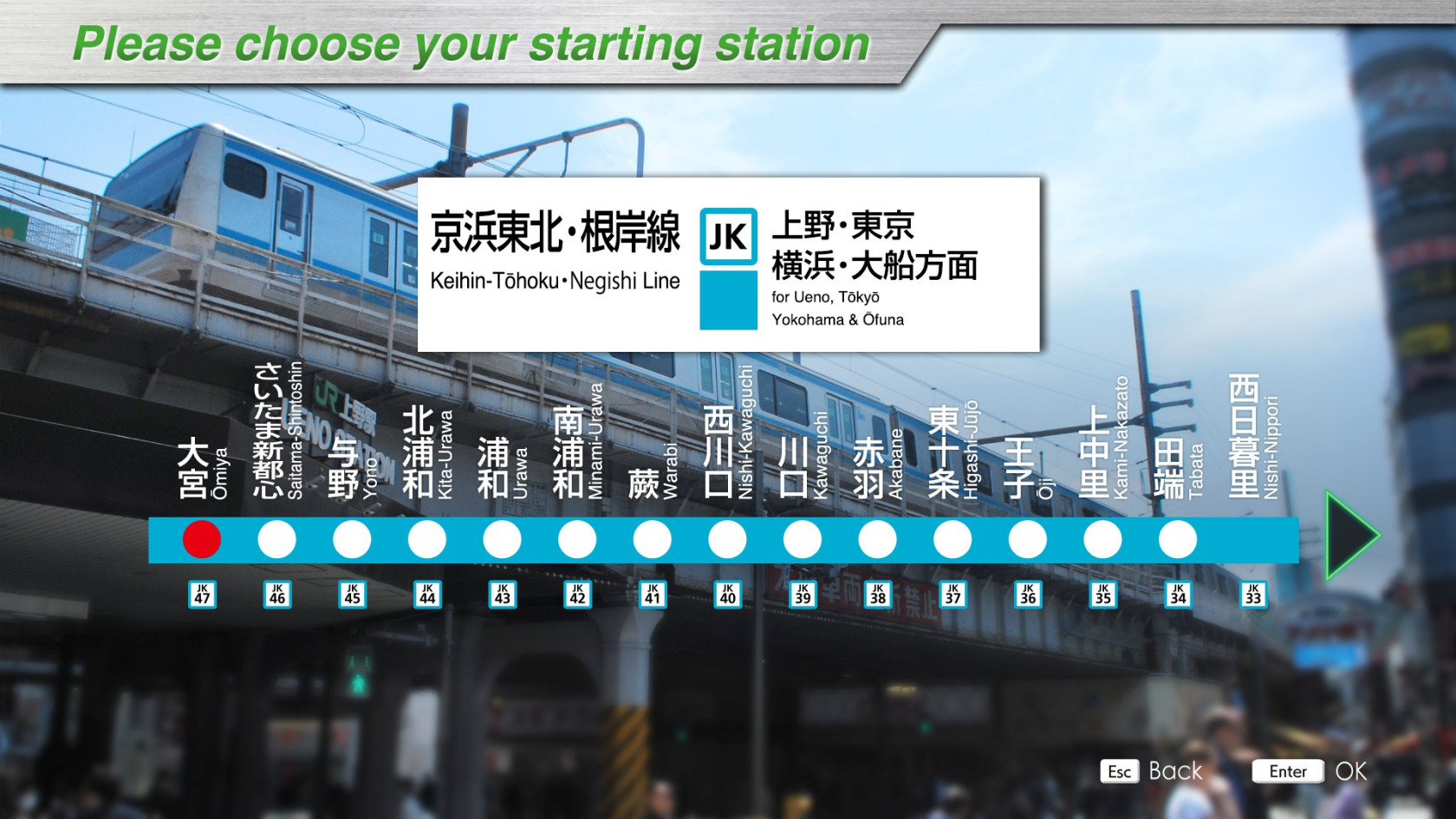Keihin-Tohoku / Negishi Line
Introducing
The Keihin-Tōhoku line is a railway line in Japan's JR East network. It connects Ōmiya in Saitama Prefecture, Tokyo and Yokohama. The line, inaugurated in 1914, has been operating for over 100 years.
The line runs parallel to the JR Yamanote line between Shinagawa and Tabata stations. With a daily ridership of over 3 million, it is one of Japan's busiest commuter lines.
The Negishi Line is a railroad line in Japan's JR East network. It connects the stations of Yokohama and Ōfuna in Kanagawa Prefecture. There is no passenger service specific to the line: trains from the Keihin-Tōhoku line continue their service on the Negishi line.
This line is included in the basic set.
Key data
- Total length : 81.2 km
- Number of stations : 46
- Safety system : D-ATC
- Train model : E233-1000 series (10 cars)
- Max speed :
- Omiya ~ Sakuragicho : 90km/h
- Sakuragicho ~ Ofuna : 95km/h
- Routes :
- Omiya ~ Ofuna (1275A) : Rapid train - 40 stations - 81.2 km
- Omiya ~ Isogo (727B) : Local train - 41 stations - 68.6 km
- Omiya ~ Ofuna (1275A) : Rapid train - 40 stations - 81.2 km
- Automatic announcements: No
- Conductor announcements: Yes
- Driver announcement (pointing-and-calling): No
Features
Note that, because the safety system is the D-ATC, the warning lights must be ignored and the Max Speed / Next Limit indicators are empty.
Note also that, because the Akabane station has landing doors, the margin of error is +/- 35cm (as on the Yamanote), regardless of the difficulty setting, but TASC data is not available, so it can't be used in this case.
Stations list
| Station name |
Japanese name |
Distance from Ōmiya (km) |
Local |
Rapid |
JRETS connections |
|---|---|---|---|---|---|
| Ōmiya | 大宮 | 0 | ● | ● |
JU Takasaki JU Utsunomiya |
| Saitama-Shintoshin | さいたま新都心 | 1,6 | ● | ● |
JU Takasaki JU Utsunomiya |
| Yono | 与野 | 2,7 | ● | ● | |
| Kita-Urawa | 北浦和 | 4,3 | ● | ● | |
| Urawa | 浦和 | 6,1 | ● | ● |
JU Takasaki JU Utsunomiya |
| Minami-Urawa | 南浦和 | 7,8 | ● | ● | |
| Warabi | 蕨 | 10,6 | ● | ● | |
| Nishi-Kawaguchi | 西川口 | 12,5 | ● | ● | |
| Kawaguchi | 川口 | 14,5 | ● | ● | |
| Akabane | 赤羽 | 17,1 | ● | ● |
JU Takasaki JU Utsunomiya |
| Higashi-Jūjō | 東十条 | 18,9 | ● | ● | |
| Ōji | 王子 | 20,4 | ● | ● | |
| Kami-Nakazato | 上中里 | 21,5 | ● | ● | |
| Tabata | 田端 | 23,2 | ● | ● |
JY Yamanote |
| Nishi-Nippori | 西日暮里 | 24,0 | ● | | |
JY Yamanote |
| Nippori | 日暮里 | 24,5 | ● | | |
JY Yamanote JJ Jōban |
| Uguisudani | 鶯谷 | 25,6 | ● | | |
JY Yamanote |
| Ueno | 上野 | 26,7 | ● | ● |
JY Yamanote JJ Jōban JU Utsunomiya JU Takasaki |
| Okachimachi | 御徒町 | 27,3 | ● | | |
JY Yamanote |
| Akihabara | 秋葉原 | 28,3 | ● | ● |
JY Yamanote |
| Kanda | 神田 | 29,0 | ● | ● |
JY Yamanote JC Chūō (rapid) |
| Tokyo | 東京 | 30,3 | ● | ● |
JY Yamanote JC Chūō (rapid) (last stop) JT Tōkaidō JU Utsunomiya (last stop) JO Sōbu (Rapid) JE Keiyō (last stop) JJ Jōban Tokaido Freight (last stop) |
| Yūrakuchō | 有楽町 | 31,1 | ● | | |
JY Yamanote |
| Shimbashi | 新橋 | 32,2 | ● | | |
JY Yamanote JJ Jōban |
| Hamamatsuchō | 浜松町 | 33,4 | ● | ● |
JY Yamanote |
| Tamachi | 田町 | 34,9 | ● | ● |
JY Yamanote |
| Shinagawa | 品川 | 37,1 | ● | ● |
JY Yamanote JJ Jōban |
| Ōimachi | 大井町 | 39,5 | ● | ● | |
| Ōmori | 大森 | 41,7 | ● | ● | |
| Kamata | 蒲田 | 44,7 | ● | ● | |
| Kawasaki | 川崎 | 48,5 | ● | ● |
JT Tōkaidō JN Nambu |
| Tsurumi | 鶴見 | 52,0 | ● | ● |
JI Tsurumi |
| Shin-Koyasu | 新子安 | 55,1 | ● | ● | |
| Higashi-Kanagawa | 東神奈川 | 57,3 | ● | ● | |
| Yokohama | 横浜 | 59,1 | ● | ● | JT Tōkaidō JO Yokosuka |
| Sakuragichō | 桜木町 | 61,1 | ● | ● | |
| Kannai | 関内 | 62,1 | ● | ● | |
| Ishikawachō | 石川町 | 62.9 | ● | ● | |
| Yamate | 山手 | 64.1 | ● | ● | |
| Negishi | 根岸 | 66.2 | ● | ● | |
| Isogo | 磯子 | 68.8 | ● | ● |
|
| Shin-Sugita | 新杉田 | 70.2 | ● |
||
| Yōkōdai | 洋光台 | 73.2 | ● | ||
| Kōnandai | 港南台 | 75.1 | ● |
||
| Hongōdai | 本郷台 | 77.6 | ● |
||
| Ōfuna | 大船 | 81.2 | ● | JT Tōkaidō JO Yokosuka |
Movie
Useful links
Wikipedia : https://en.wikipedia.org/wiki/Keihin–Tōhoku_Line - https://en.wikipedia.org/wiki/Negishi_Line
Driver's guide and timetables: https://docs.google.com/spreadsheets/d/1qFyJVimA8cCBda6Iq064m5uuelpWd28X0FDERZQJ1fQ/edit#gid=426048143

